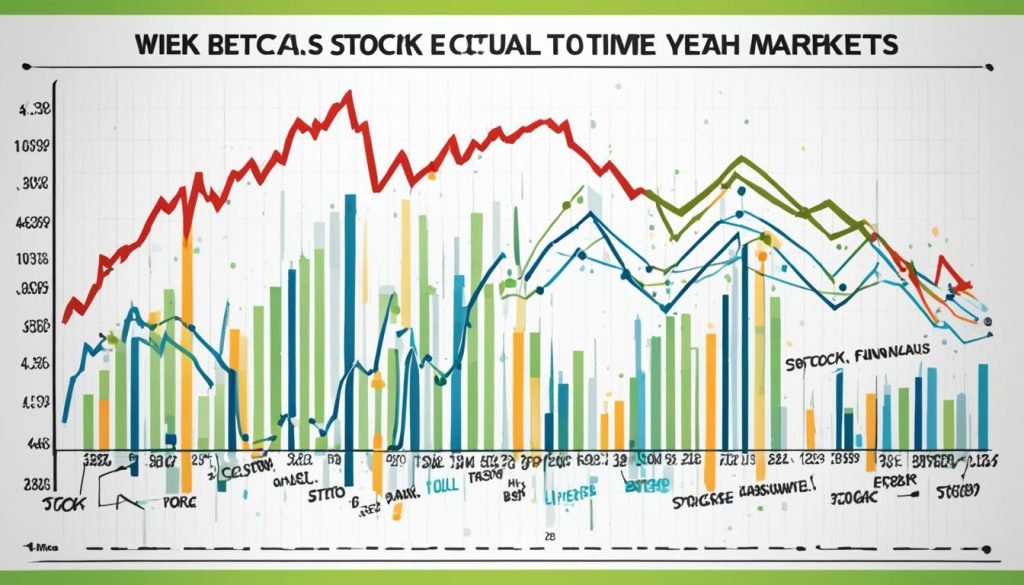For traders and investors, knowing the basics of fundamental investing is key. It involves looking at a company’s financials to find the true worth of its stock. You’ll check SEC filings, the company’s statements, and growth metrics. This includes looking at revenue, earnings, and profit margins.
You also explore the company’s debts and its ability to pay them, as well as stock rates. It’s important to consider broader economic trends, like consumer confidence and industry changes. Other factors like government decisions, inflation, and market trends play a role too.
Technical analysis, like reading stock patterns, helps in choosing the right time to buy or sell a stock. This blend of methods helps in making smart investing choices.
Key Takeaways:
- Knowing fundamental investing is vital for making smart trading choices.
- It means looking at a company’s financial information, like its filings.
- Understanding overall economic trends also helps in stock market understanding.
- Technical tools can pinpoint when to buy or sell a stock.
- Keeping up with market news and economic conditions is key to investing success.
Investing starts with understanding a company’s financial situation. This info, along with market trends, helps in making wise investment decisions. Tools like studying stock patterns further refine your buying and selling strategies.
Growing wealth through smart investments requires knowing the fundamental investing rules. Diversifying your investments and managing risks are crucial. Also, understanding market dynamics can enhance your investment’s performance.
For both new and seasoned investors, solid knowledge of investment basics is crucial. Keep learning, stay updated with market trends, and you’ll be closer to reaching your financial goals.
Understanding Stock Fundamentals
Stock fundamentals are key for studying a company’s money matters. These include cash flow, return on assets (ROA), and how much debt a company holds. Investors use these to understand if a stock is a good buy.
The analysis of stock essentials looks past just the stock’s price changes. It digs into a company’s financial details to see its true value and future potential.
Cash flow, the money moving in and out of a business, is critical. If it’s positive, the company is likely doing well financially.
ROA shows how well a company turns its assets into profit. A high ROA means the company uses its resources well and could make more for its shareholders.
Conservative gearing measures how much a company depends on debt. A lower dependency usually means a more financially stable firm.
Keeping profits to invest in new opportunities is vital for growth. Companies that do this well might offer more to their shareholders.
When thinking about stocks, it’s important to know if a company can pay its bills now and later.
To really get stock fundamentals, you need to look at a company’s financial reports and other details. These show the company’s health and potential future.
Example: Stock Fundamentals Comparison
| Company | Cash Flow | ROA | Conservative Gearing | Profit Retention | Financial Stability |
|---|---|---|---|---|---|
| Company A | $10 million | 8% | 30% | 70% | Stable |
| Company B | $5 million | 10% | 20% | 50% | Stable |
| Company C | $8 million | 6% | 40% | 60% | Stable |
In the table above, we look at three companies’ fundamentals. Company A stands out with solid cash flow and profit retention. This shows it’s financially healthy and can reward its investors well. Company B does very well in asset management, while Company C shows strong debt management.
Studying these fundamentals helps investors pick the right stocks by understanding the company’s finances, stability, and potential to grow.
How the Stock Market Works
The stock market runs through stock exchanges like the NYSE and Nasdaq. They decide stock prices by supply and demand.
Individuals who want to trade stocks usually go through brokers. These brokers, whether online or offline, help connect traders with the market.
The NYSE and Nasdaq are open from 9:30 a.m. to 4 p.m. ET. But, some brokers allow trading even before or after these times, giving traders more chances to trade.
Knowing how the stock market operates is key if you plan to trade stocks. Investors often watch key market indexes, like the S&P 500, to see how well the market is doing.
If you’re investing for retirement, understanding the stock market is crucial. It’s important to choose investments based on your risk tolerance, time you have, and spreading your investments out.
Benefits of Understanding the Stock Market
Understanding the stock market helps investors make better choices.
- Knowing market hours lets you plan your trades well.
- Watching indexes gives you insights on market trends.
- Learning about brokers helps you pick the best one for your trades.
- Understanding supply and demand is key to evaluating stock prices.
Grasping how the stock market works is a major step toward successful investing. This can be for the short term or for planning your retirement.

Seeing a diagram of the stock market can help you understand it better. The image above shows a clear view of how the stock market is made up.
Stock Trading Basics
Long-term investing grows a diverse portfolio over time. Stock trading, on the other hand, involves more buying and selling. The goal is to gain from short-term market moves and trends. Traders make these moves to earn profits fast, based on market timing and quick gain spots.
Stock traders may trade within days or months, also known as day trading or active trading. They spend a lot of time researching and analyzing market movements. They use tools like technical stock analysis and data from brokers online to make smart trade decisions.
Technical stock analysis is crucial in stock trading. It looks at past prices and volumes, finds trade patterns, and predicts future price moves. With the help of charting tools, traders can see trends visually. This aids in making better decisions.
“Stock trading is an active approach that requires deep market knowledge and technical analysis skill. To be successful, traders use stock research and charts to make smart decisions.”
How Technical Stock Analysis Works
Technical stock analysis uses many tools and methods to understand stock prices. Some of these include:
- Identifying support and resistance levels where a stock’s price has had trouble moving above or below. These help traders find good times to buy or sell.
- Moving averages smooth out data by figuring the average price over time. Traders watch different averages to predict trends.
- Indicators like RSI and MACD show a stock’s momentum and movement strength. This helps traders spot buying or selling chances.
- Chart patterns, like head and shoulders, offer clues about market trends. Traders use these patterns as signals for their trades.
Understanding these tools means always learning and practicing. Successful traders are always adapting to the market’s changes and trends.
Comparison of Stock Trading Strategies
| Stock Trading Strategy | Description | Advantages | Disadvantages |
|---|---|---|---|
| Day Trading | Profiting from short-term price shifts within a day. | – Quick profit potential – Lots of chances to trade – Can focus on specific stocks |
– Needs a big time investment – High risk and fees – Trading can be costly |
| Swing Trading | Takes advantage of short-term market moves, holding for days to weeks. | – Captures medium price changes – Good for part-time traders – Better returns than long-term |
– Moderately risky with market shifts – Needs constant monitoring – Must avoid emotional trades |
| Momentum Trading | Picking stocks with strong recent movement to profit from ongoing trends. | – Opportunity for quick gains – Can ride strong market waves – Makes fast trading decisions |
– Must watch the market all the time – High risk with fast price shifts – Must avoid overtrading |
Stock trading lets people get actively involved in the market, using tools and research to trade wisely. This can include day, swing, or momentum trading. Success in this field requires continual education, practice, and market awareness. These are vital for anyone looking to do well in stock trading.
Bull Markets, Bear Markets, and Stock Market Corrections
The stock market moves through phases like bull markets, bear markets, and corrections. These are based on growth, market performance, and indexes. They come and go as the economy changes.
During a bull market, prices go up and people feel good about investing. This shows the economy is doing well. People tend to make money during these times. This happens because more people are buying things, companies are doing very well, and the government’s rules help.
“Bull markets are times when the stock market feels hopeful and positive. People believe prices will keep rising, which could make them wealthier.”
In a bear market, prices fall, and confidence ebbs away. These downturns can be scary, with stocks losing 20% or more. They often happen when things are uncertain, when we’re in a recession, or if there’s trouble worldwide.
Both bull and bear markets are part of the stock market’s rhythm. Bulls last longer than bears, which are shorter but harder. Knowing about these cycles helps investors know when to act with their money.
Then, there are corrections, when the market drops a bit but not too much. A drop of 10% or more but less than 20% is a correction. They’re healthy adjustments for the market. They might even be good times to buy for investors.
Don’t be fooled by the ups and downs of the stock market. Remember, it’s a natural process with risks and rewards. Knowing this can guide smarter investment choices.

Bull Markets and Bear Markets Comparison:
| Bull Markets | Bear Markets | |
|---|---|---|
| Characteristics | Rising stock prices, positive investor sentiment | Declining stock prices, negative investor sentiment |
| Length | Typically longer | Shorter but more intense |
| Economic Conditions | Economic growth, increased consumer spending | Economic uncertainty, recession |
| Investor Behavior | Optimism, potential wealth accumulation | Caution, potential economic contractions |
H3: Stock Market Crashes
Crashes are big, sudden drops in the stock market. They can be caused by serious economic problems or global issues. A crash can cause fear and a rush to sell, which quickly lowers the value of portfolios.
It’s crucial for investors to stay steady during a stock market crash. Making quick decisions because of fear can be harmful. Keep calm and focus on long-term goals.
“Stock market crashes are rare but powerful, affecting the economy and markets for years.”
These crashes are hard to predict. Having a diverse portfolio can make you more resilient to market swings. Spread your investments across various types and areas to lower risk.
Knowing about market cycles helps investors. Understanding bull markets, bear markets, and corrections can lead to better choices. Remember, the stock market has its ups and downs. But, thinking long-term is key for success in investing.
Conclusion
It’s crucial to know the basics of the stock market for smart investing. You should look at a company’s essentials and important numbers to understand a stock’s value and where it could go. This approach, called fundamental investing, helps traders refine their buying and selling times.
But, to lower risks and boost earnings, it’s vital to have a varied portfolio and think long-term. Doing so also means keeping up with what’s happening in the market and the world. Remember, the way you invest or trade should match what you want to achieve and how much risk you’re okay with taking.




